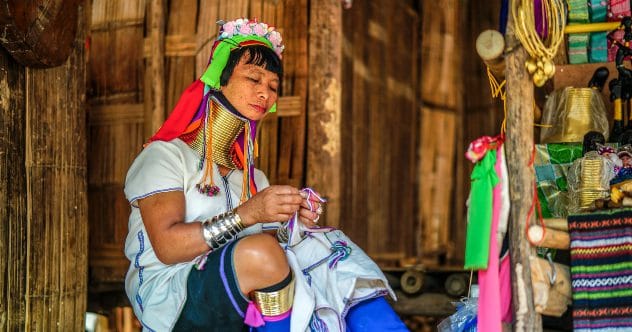Fashion is a beautiful way to express ourselves, a vibrant art form that’s always changing and surprising us. But what happens when the quest for the latest look takes a dark turn? Throughout history, some fashion trends have gone beyond merely questionable, becoming downright dangerous. And often, especially in Western societies, these perilous paths of style have been walked by women, who endured seriously unsafe practices to meet ever-shifting beauty ideals. From deadly chemicals to painful body modifications, let’s uncover ten of the most dangerous fashion choices women have somehow faced.
10 Lead, Arsenic, & Mercury—Oh My
For centuries, what seemed like harmless beauty products often contained a cocktail of deadly chemicals. Women have unknowingly poisoned themselves in the name of fashion for as long as beauty rituals have existed. The list of culprits is long and terrifying, including things like turpentine, formaldehyde, and parabens, alongside the infamous trio of lead, arsenic, and mercury.
Consider these shocking examples:
- Arsenic-laced pads were used to achieve a pale complexion. How did they work? By insidiously killing the red blood cells under the skin.
- Lead powder was a staple for creating the ghostly white face that was the height of Baroque fashion.
- A vibrant dye called Scheele’s Green, made with arsenic, lent its color to fabrics but also caused cancer with repeated exposure.
- Hats treated with mercury led to severe neurological disorders. This is the origin of the phrase “mad as a hatter,” a chilling reminder of fashion’s toxic past.
9 Neck Rings
Neck rings, a striking and often debated fashion, have appeared in various cultures across Africa and Asia. The practice typically begins in childhood, with metal rings being added around a young girl’s neck as she grows. If any space appears, more rings are added, or a single coil is wound tighter. The desired effect is an elongated neck, which is considered a mark of beauty.
However, the reality is quite different and far more concerning. The neck itself doesn’t actually stretch. Instead, the sheer weight and continuous pressure of the rings push down on the collarbone (clavicle) and ribs. This immense force can warp these bones, bending them downwards at unnatural angles. Such skeletal deformation can lead to serious health problems, including issues with blood circulation and clotting, as soft tissues are compressed by misplaced bones. In some cultures, girls might even start the process later as preteens, wearing extra rings to “catch up,” accelerating this unhealthy bone deformation in a painful way.
8 DIY Piercings
Piercings are, at their core, intentionally created wounds. This fact alone should make anyone pause and think, “Perhaps a professional should handle this.” Yet, many individuals attempt to perform their own piercings at home. The easy availability of DIY at-home piercing kits online has unfortunately made this risky option more tempting for those looking to save a bit of money.
There are numerous dangers involved when you decide to pierce yourself at home, with infection being the most common. Professional piercing studios must adhere to strict hygiene standards to minimize infection risks—standards that are rarely met in a home environment. Professionals use gloves, sterilize their tools, the piercing site, and the room itself. They are also trained to perform the procedure competently. None of these safeguards are guaranteed with DIY piercings, where a lack of training and proper sterilization can lead to nasty infections or even the transmission of diseases if done incorrectly.
7 Tho-Radia
During the 1920s and 1930s, a bizarre and dangerous fashion craze swept through society: products containing radioactive elements. Scientists had only recently discovered elements like thorium and radium. To an uninformed public, these were simply new, exciting materials brimming with mysterious energy. This buzz was enough to launch a fad, and soon, thorium and radium started appearing in all sorts of consumer goods.
One prominent example was a line of cosmetics called Tho-Radia, named for its active ingredients: thorium and radium. This product range included everything from face creams and lipsticks to soaps and even soft drinks. All these items were marketed as miracle products, their “mysterious energetic properties” touted to cure anything from aching bones to wrinkles. Of course, these products didn’t work as advertised. Instead, an entire generation of women who used them saw a frightening increase in cancer rates, a tragic consequence of this radioactive allure.
6 High Heels
High heels might not seem as immediately life-threatening as some other items on this list. However, what they lack in swift danger to an individual, they make up for in gradual, widespread harm to millions of wearers. And it’s worth noting that some historical high heels were far taller and more precarious than what’s common today.
Repeatedly wearing high heels, even the modern varieties, can literally reshape the Achilles tendon and calf muscles to accommodate the foot’s altered angle. This unnatural posture places significant stress on the knees, hips, and back as the body tries to adapt to an awkward gait. Over time, this can lead to conditions like osteoarthritis, stress fractures, and chronic pain. Moreover, historical footwear like the chopines popular in the eighteenth century were shockingly tall, resembling strange, almost alien-like platforms with foot straps, making them even more hazardous.
5 Corsets
It’s almost unbelievable that corsets were a widespread fashion staple for hundreds of years. The concept behind them was simple: a fabric frame, often reinforced with boning, was tightly cinched around the torso. The goal was to dramatically slim the waist, which had the added effect of pushing up the bust and making the hips appear wider, creating the fashionable hourglass figure.
And while corsets certainly achieved this visual effect, they did so by exerting enough prolonged pressure on the torso to deform and damage internal organs. Medical evidence and historical accounts show that corsets could misalign the bowels, leading to painful blockages. They also compressed the lungs, reducing breathing capacity and making wearers more susceptible to respiratory infections. Tragically, corsets could even be fatal. There are multiple recorded instances of women dying due to their corsets, either through slow suffocation or, in the infamous case of Mary Halliday, because the corset stays were laced so tightly they reportedly pierced her heart.
4 Crinoline
One of the most iconic fashion trends of the Victorian era was the hoop skirt. These wide, flowing, circular skirts gave Victorian women their distinctive silhouette: a tiny waist atop a voluminous lower half. These skirts maintained their impressive size thanks to underlying cages known as crinolines. However, because of these crinolines, hoop skirts became a deadly hazard, claiming the lives of thousands of women.
The dangers associated with crinolines were twofold. Firstly, the materials used to construct them were often highly flammable. Secondly, the immense, rigid shape created by the crinoline made the skirts incredibly wide and unwieldy. This made it difficult for wearers to manage their garments, leading to skirts easily getting caught in machinery, wagon wheels, or brushing against open flames. Numerous Victorian-era women tragically caught fire or were ensnared by moving parts due to their cumbersome skirts. While exact figures vary, historical reports consistently place the death toll from these flammable and unwieldy garments in the thousands.
3 Foot Binding
Foot binding was a deeply ingrained practice in China that persisted for roughly a thousand years. It involved breaking and tightly binding the feet of young girls to reshape them into a smaller, often pointier form, known as “lotus feet.” The process typically began when a girl was between four and nine years old. It started with systematically breaking each of the toes and folding them under the sole of the foot. Then, the arch of the foot was broken and bound tightly with long strips of cloth to force it into the desired compact shape.
This brutal procedure was incredibly painful and led to lifelong disabilities. During the binding, toenails often grew into the flesh, causing severe infections. These infections sometimes led to the flesh rotting and toes falling off completely. Painful as it is to imagine, this loss of toes was sometimes considered a “bonus,” as it allowed the feet to be bound into an even smaller and more “desirable” shape. By the peak of its popularity in the 19th century, a vast majority of women in China had their feet bound and permanently disfigured by this tradition.
2 Heroin Chic
The pursuit of thinness has been a dominant theme in fashion across many cultures for centuries. Countless women can attest to the struggle of chasing the ever-moving target of the “ideal” feminine physique. However, the 1990s took this pursuit to a particularly dark and disturbing place with the emergence of a trend known as “heroin chic.”
As its name chillingly implies, heroin chic glamorized the look associated with heroin use. This specifically referred to the gaunt, skeletal thinness that often accompanies addiction, along with other signs of poor health like dark circles under the eyes and pallid skin. Fashion photography promoting this aesthetic frequently depicted models looking dazed, unsmiling, and posed in bleak settings like against grimy walls or in alleyways. The dangerous romanticization of this look reached a tragic climax when photographer Davide Sorrenti, one of its prominent proponents, himself died from issues related to heroin use, starkly highlighting the destructive reality behind the “chic” facade.
1 Rib Removal
It’s hard to grasp that people would willingly undergo surgery to remove bones from their body simply for the sake of an aesthetic ideal. What’s perhaps even more surprising is that this practice isn’t some relic of a distant, unenlightened past—it’s a modern phenomenon. Yes, right now, there are individuals who choose to have two, four, or even six of their lower ribs surgically removed, all to achieve a dramatically thinner waist. For many, the aspiration is to emulate the proportions of figures like Barbie dolls or exaggerated cartoon characters.
The price for this cartoonishly small waist begins with an invasive surgical procedure. Any surgery carries inherent risks, such as infection, complications from anesthesia, and internal bleeding. Most reputable doctors will advise that such procedures are typically reserved as a last resort for medical necessities, not elective cosmetic alterations. Beyond the surgical risks, the removal of ribs significantly increases the vulnerability of vital internal organs. After all, ribs serve a crucial protective function, shielding your lungs, heart, and other organs from impact. Without their sturdy framework, the risk of severe injury, like a collapsed lung from a relatively minor blow, becomes dangerously high.
Fashion is a powerful form of self-expression, but as we’ve seen, the pursuit of beauty has sometimes led women down treacherous paths. From toxic cosmetics in ancient times to extreme surgical modifications today, these dangerous trends highlight the intense societal pressures and personal sacrifices made in the name of style. It’s a stark reminder to consider the true cost of beauty and to champion trends that empower and celebrate health, rather than compromise it.
What are your thoughts on these dangerous fashion trends? Have you heard of others that deserve a mention? Leave your comment below and join the conversation!










